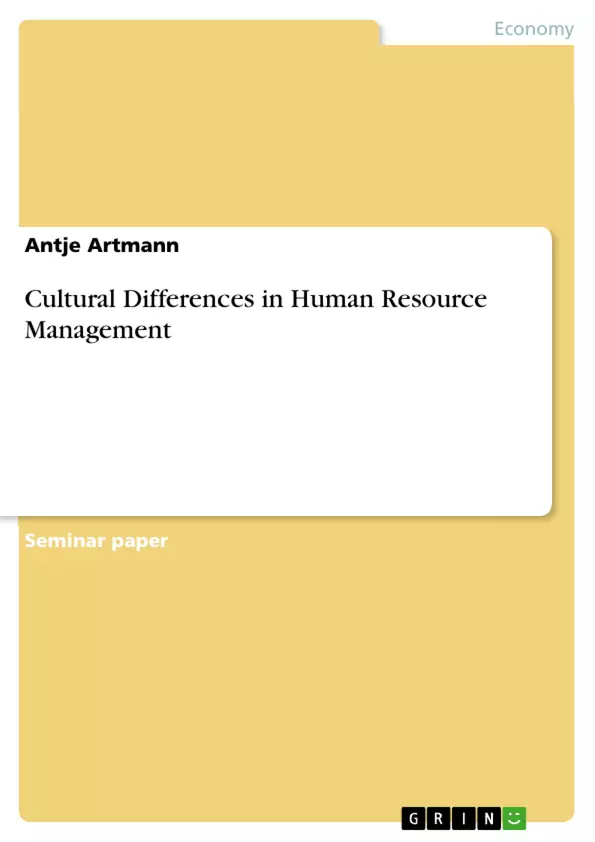“Human resource professionals are often treated as if they were the lowest form of managerial life” (E.P. Lazear, 1998). Usually, personnel skills are perceived as too soft and are thus not valued as an essential tool for managing a company efficiently. Moreover, personnel people had to get used to receive little respect from their colleagues in the last century. Human resource managers were viewed as the “company police”, who created unnecessary stepping-stones for others. This impression has reasoning. Until recently, there existed no systematic guide, on which human resource decisions could be based. In fact, personnel matters were regarded as too soft and too human to be treated rigorously. One of the main reasons is the fact that in the past as well as today most managers are technical experts. Sequentially, this led to the conclusion that human resource management indeed does not matter. However, today’s managers perceive human resource management as an important tool in order to run a company smoothly, effectively and cost-efficient. Indeed, human resource management determines how the company’s resources are managed. Human resource planning is essential in order to ensure that an organization’s human resources are capable of meeting the firm’s operational objectives. Thus, the following problem statement arises: Does the way of managing human resources diverge in different cultures and institutions?
In the following paper, the relative importance of human resource management between different cultures will be evaluated. Special attention will be given to the Czech Republic, Asia und the public service sector in the USA. First, a general definition of human resource management will be provided heavily influenced by U.S.-originating thoughts. Afterwards, the different cultures with respect to personnel matters will be explained and compared. Of special importance are the areas assessing, hiring and training of new employees. Finally, a conclusion will be provided, including an answer to the above stated question.
Inhaltsverzeichnis (Table of Contents)
- INTRODUCTION
- A GENERAL DEFINITION
- THE CZECH REPUBLIC
- HUMAN RESOURCE MANAGEMENT
- EMPLOYEE ASSESSMENT
- RECRUITMENT
- TRAINING
- ASIA
- THE PUBLIC SERVICE
- HUMAN RESOURCE PLANNING
- ASSESSMENT OF NEW EMPLOYEES
- ASSESSING EXISTING HUMAN RESOURCE CAPACITY
- RECRUITMENT
- PERFORMANCE MANAGEMENT AND TRAINING
- HUMAN RESOURCE PLANNING
- COMPARISON
- CONCLUSION
Zielsetzung und Themenschwerpunkte (Objectives and Key Themes)
This paper explores the significance of human resource management in different cultures, focusing on its application in the Czech Republic, Asia, and the public service sector in the United States. It aims to determine if the practices of managing human resources diverge across different cultures and institutions.
- Cultural differences in human resource management practices
- The impact of culture on employee assessment, recruitment, and training
- The role of human resource management in organizational success
- The importance of non-financial rewards and employee motivation
- The challenges of implementing effective human resource management strategies in different cultural contexts
Zusammenfassung der Kapitel (Chapter Summaries)
The introduction highlights the often-overlooked importance of human resource management and introduces the paper's objective to examine cultural differences in this field.
The "General Definition" chapter outlines key aspects of human resource management, including recruitment, turnover, training, and motivation.
The "Czech Republic" chapter delves into the relatively low importance attributed to human resource management in this country. It discusses how it is often seen as an administrative act rather than a strategic tool. The chapter then focuses on specific practices related to employee assessment, recruitment, and training, highlighting their weaknesses and limitations.
The "Asia" chapter provides a brief overview of human resource management practices in Asia, although specific details and examples are not provided in the preview.
The "Public Service" chapter examines human resource practices within the public service sector in the United States, covering areas such as human resource planning, recruitment, and performance management and training.
The "Comparison" chapter, although not summarized, likely compares and contrasts the human resource practices discussed in previous chapters, highlighting key similarities and differences across cultures.
The "Conclusion" chapter, which is not included in the preview to avoid spoilers, likely offers a summary of the key findings and answers the question posed in the introduction about the divergence of human resource management practices across different cultures.
Schlüsselwörter (Keywords)
The key terms and concepts explored in this paper include human resource management, cultural differences, employee assessment, recruitment, training, motivation, Czech Republic, Asia, public service, and comparative management. The paper analyzes the effectiveness of human resource management practices in various cultural contexts and investigates how cultural factors influence employee behavior and organizational performance.
- Citar trabajo
- Antje Artmann (Autor), 2002, Cultural Differences in Human Resource Management, Múnich, GRIN Verlag, https://www.grin.com/document/4534



